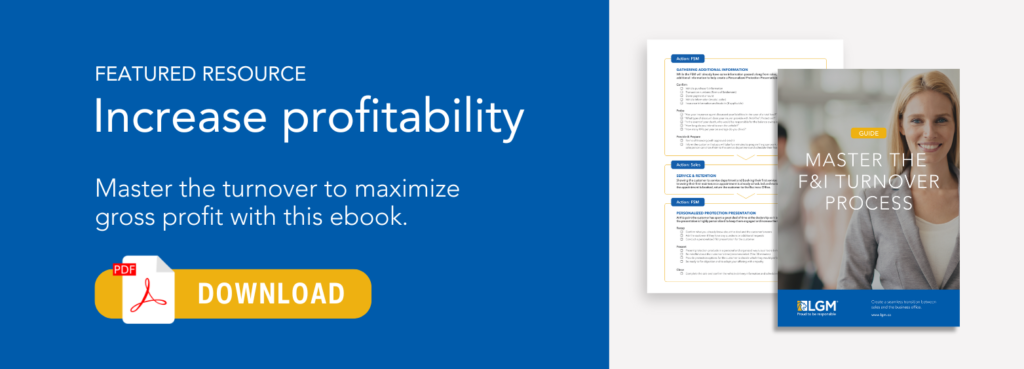A dealership that can perform the ‘turnover’ correctly will run like a well-oiled machine and create excellent customer experiences.
What is the ‘turnover’ and why is it so important?
The ‘turnover’ is a term used in car dealerships to refer to the process of transitioning the customer from the car salesperson to the financial services manager (FSM).
Once the salesperson has helped the customer decide on a vehicle, and they are ready to purchase, the customer will then be introduced to the FSM who will help finance their vehicle and offer them protection products.
The turnover process may sound simple, but in practice it is important to get it right. A proper turnover should create a seamless experience for the customer, giving them peace of mind about their purchase. The turnover is also critical for building a lasting relationship with the customer.
The DO’s and DON’Ts for mastering the ‘turnover’
Let’s dive into how this process should look from beginning to end with some do’s and don’ts for each dealership department.
DO: Understand the customer’s POV.
When the customer first walks into the dealership, they can be met with a rollercoaster of emotions. They’re likely excited for their purchase, but also concerned about making the right decision. They may also be anxious about their credit score or the payments that they’ll have to make. They could even be worried about whether they’ll be able to negotiate a good deal.
The salesperson’s first step should be to understand and empathize with the customer. By humanizing your interaction and ensuring that you’re there to help, you’ll be able to calm their nerves and make them feel more comfortable about this large purchase they’re about to make.
DON’T: Make assumptions about the customer’s needs.
The salesperson should never make assumptions about the customer’s feelings or needs. Every customer is different, so taking the time to get to know your customer’s specific needs will go a long way towards helping them drive away confidently in the right vehicle.
DO: Be the customer’s trusted advisor.
Once you can sense how the customer is feeling, you can make a better judgment on how to approach their situation. The salesperson should be taking the time to perform a needs assessment and slowly walk them through their options.
Knowing that finances are a typical pain point for most, the customer should be informed about how they’ll have the option to protect their vehicle with proper finance and insurance (F&I) products before they even get to the financial services office. This not only gives the customer more peace of mind about the financial commitment that they’re making, but it also allows them to feel more confident to know their protection options and allows them to walk into the FSO with some peace of mind.
DON’T: Rush the process.
As we mentioned, it is important to perform a needs assessment and slowly walk the customer through the process. It may be the customer’s first time in a dealership since the pandemic (or ever!), so don’t expect them to know what is coming next. Outline expectations for the customer to help settle their nerves and make them feel comfortable with you.
DO: Introduce the customer to the FSM and explain how they’ll help.
The salesperson can help set the FSM up for success by presenting them with an informed customer.
It is also helpful for building a lasting relationship between the customer and your dealership because with their F&I products, they will come back to your service department knowing their vehicle will be well taken care of.
To properly introduce the customer to the FSM, the salesperson should:
- Introduce both the FSM and customer by name.
- Mention the FSM’s role, their expertise in financing and credit application, and any other information that will help the customer feel at ease.
- Share that the FSM is trained to understand the specific regulations around financial protection products and are here to help protect and maintain their vehicle with OEM grade servicing and customized protection.
DON’T: Leave it up to the customer to get to know their FSM.
What makes the turnover such a pivotal part of the customer’s experience is that as soon as they become comfortable with the salesperson helping them through their buying journey, they are passed over to a new person (the FSM), and they have to start building their trust again from the ground up.
The salesperson should not be handing over the customer without a thorough introduction.
DO: Recap the transaction and be transparent about product offerings.
While the salesperson has a lot to consider when setting the customer up for a comfortable experience, the FSM also has to hold up their end of the bargain. We can expect that there will be a bit of discomfort on the customer’s end because discussing finances is not always easy. They may also be worried about their credit situation or being forced into a bad deal.
First, the FSM must recap the transaction with the customer. The customer may have had some specific requests for their vehicle, so the FSM should summarize the details of the transaction and ask if the customer has any questions to ensure the customer feels well informed about their purchase.
Second, the FSM needs to be transparent about the risks and benefits of the protection products being offered. Considering that many customers experience waves of emotion in the financial services office, their mind could be wandering, so the FSM should try to help them be present by clearly communicating each product. The worst possible experience for a customer would be to leave the meeting with the FSM feeling like they weren’t able to understand the details of their purchase or speak up. Throughout this process, the FSM should constantly be asking the customer if they have any questions or need further clarification.
Customers tend to appreciate an FSM who demonstrates their extensive product knowledge while also maintaining their integrity by ensuring that they are offering F&I solutions that truly meet their needs and budget.
DON’T: Expect the customer to know what they need right away.
The FSM should never assume what the salesperson has already explained to the customer. They should be prepared to fully communicate their process in a clear and transparent way and allow the customer to tell them what they do or do not already know.
Hopefully, the customer is coming in with some information based on their previous interaction with the salesperson, but they likely won’t know what their specific financial needs are at this point. When the customer doesn’t know what they don’t know, they cannot make a fully informed decision. This is why the FSM must be ready to answer any of their questions to make sure they’re driving away with the right protection.
Start mastering the ‘turnover’ at your dealership
The turnover is a key part of the customer’s experience in the dealership and can make or break their confidence in your staff. By following the do’s and don’ts in this article, your dealership can start building strong lasting relationships and help instill peace of mind in your customers.
Click the button below to download LGM’s step-by-step turnover process to share with your sales staff and financial services managers.




